The conflict in Ukraine gets hotter and more and more people in the world get concerned. How is this supposed to end? Feeling unable to do something about a situation is never nice. The wait for the DGAC permit continued. It was boring.
But then, suddenly, it arrives. I add the permit number as a remark in Field 18 of the ICAO flight plan form and send an email to CORPAC, the Peruvian air traffic control company, as there is no flight plan office in Lib Mandi.
Alberth and I move the plane out of the hangar.
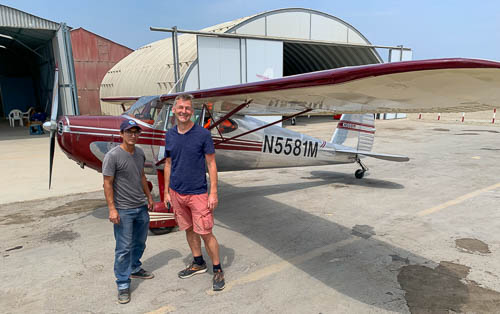
45 minutes after filing the flight plan, I start the engine, taxi to the holding position and ask Lib Mandi Info if they have my flight plan. They don’t. After some waiting, I taxi back, disappointed. What happened? Alberth helps me to find out. I filed a flight plan to Nazcar, overflying Pisco. But for whatever reason, they want me to land in Pisco. Pisco is the first airport listed in my permission, yes, but shouldn’t you normally list airports there, so you can use them as alternates? I email a new flight plan, now with destination Pisco. Then I wait again. It is getting late now; will I ever get off the ground in Lib Mandi? And can I still make my second flight today, from Pisco to Chala before sunset?
Alberth tells me, they should have my flight plan now - and they do.
I take off at 17:26 UTC, 12:26 local time. I haven’t flown N5581M since August and I immediately love it. With a wide left turn, I fly around beautiful San Bartolo and follow the coast to the south. I am flying VFR, but most of the time in Airspace Delta, which means I fly with two-way radio communication to ATC, with a squawk and an assigned Flight Level. I roughly follow the coastline and it feels the same as last time, 2 years ago. The journey continues.
There is much to see. Chino pointed out which ruins and archeological sites I must overfly, but I was too busy managing the flight, missing the routine I had two years ago and missing most of the sites. But I could see a lot of undeveloped beautiful coastline. I didn’t see any other air traffic, but watched anxiously the oil temperature nearing the red line during the climb. Las Palmas sent me over to Pisco Tower. Pisco airport, the second largest in Peru after Lima, is located close to the city, easy to spot. They clear me to land on runway 22. I do a nice three-point landing at 13:37 and taxi to the south apron for refueling.
Afterwards, I walk into the flight plan office and get told, that my chosen alternate Nazca closes at 5 PM. It is past 2 PM now and with a flight time of 2:30 to my destination Chala and potentially 50 minutes from there to Nazca I have to admit that I wouldn’t be able to land before 5 PM. Why does an airport have to close at 5 PM, 90 minutes prior sunset? Unfortunately, there are no other airfields available near Chala. So I agree and called it a day. I taxi the 140 to overnight parking, leave the airport, walk towards Pisco's fishing harbor.
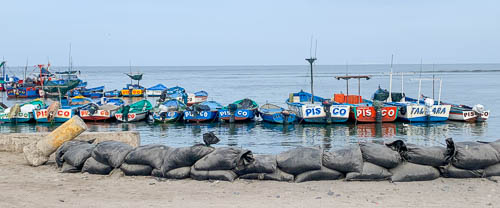
In the harbor area, I look for a hotel room. The first two hotels were I ask are booked out. Oh, it is weekend again, I better book my next hotel room temprano. As it is still early, I take another walk along the beach promenade, looking for dinner. I find a nice family-owned restaurant. It is still early for dinner, so I ask, if the kitchen is open. Apparently, the family is having dinner themselves. After I place my order (A liter of Chicha Morada and the catch of the day) they invite me to their table, and we exchange stories about operating a restaurant and - diving. They have a diving business. Lots of people come to Pisco for scuba diving.
A good thing about flying in this region at this time of the year: Weather is not a big issue. There is some haze in the morning, but it quickly dissipates. Wind hasn’t been too strong either, just enough to take it into consideration when planning flight levels.
I choose FL 75 again. Not only, because this level offers a slight tailwind while lower levels had headwinds. No, main reason is that the Peruvian military blocks large airspaces along the coast; I must fly over the ocean, the shoreline sometimes being more than 10 nautical miles away. Flying higher means less time exposed – unable to reach the beach, if the engine quits. Chino is unhappy about this situation and fights it. One man on a crusade against the military? I love this attitude.
I walk into the Pisco airport passenger terminal at 8 AM. The sleepy guard wants to see my boarding pass. I have none, I am tripulante. Ok, so where is your declaracion general?, he asks. I have none, I arrived in Peru as passenger, I explain in my poor Spanish. After 20 minutes of phone calls, an airport official arrives, we create a GenDec and I am allowed to pass security.
At AIS, I have to fill out the flight plan form again. The one I did yesterday, had a mistake. Mistakes cannot be corrected on the paper form. A new form must be filled out. Knowing, that there is no flight plan office at my destination Chala, I file a flight plan for the second flight of the day, from Chala to Mollendo. Again, I do a mistake and have to start all over. I am missing the routine and the Peruvians are very strict. It takes over an hour, the airport official was patiently waiting. Everybody working in Pisco airport was waiting, most of the time. They only have a few airline flights a day. And only when these flights require service, the people working here are in a hurry. But this is the same at many regional airports. I know, that after filing the flight plan, I have to wait an hour, before I can take off. So I am in no hurry, while I pay my fees. Cash, effectivio, US dollars or soles, but no credit cards are accepted. Nobody has change. Not the fuel agent, not at AIS, not at the airport office. I run out of small bills. Prices are moderate. I mean, flying in your private aircraft to a controlled airport is never cheap, but here in Peru it is not as expensive as – say – Nicaragua or – good beware – Costa Rica and Ecuador.
After takeoff, there is an anxious moment. My clearance was to follow the coastline, and this is what I intended. But I wanted to shortcut a bit, to stay out of a restricted area, believing that this is what I was supposed to do. What I didn’t do was clarify the clearance with the tower. N5581M, what is your position? You are within a restricted area, the tower blamed me. No, I am outside all restricted areas, I snapped back. There is another restricted area, and you are inside it. Your clearance was to follow the coastline, insisted the tower. Never argue with the locals, they are usually right, I thought and turned towards the coastline. The tower didn’t press the matter further. Passing 35 miles outbound, the tower askes me to contact Nazca tower when in range and wishes me a good flight. The radio gets quit. The landscape is just gorgeous. This is where they filmed the Apollo 11 landing, commented Mitch. They could film the Mars landing here too, I texted back.
After some time, I heard Nazca tower, busily coordinating the Cessnas flying tourists to the famous lines. I wish my route would have taken me over it, but from Pisco the better way to Chala was along the coast, 50 miles west of the famous old lines. From a safety standpoint it is better to avoid this busy area anyhow. There is a lot of VFR traffic over the lines and there have been midair collisions in the past.
Furthermore, I guess that they don’t want foreigners without a concession flying over the lines anyhow – at least this is how I read the Nazca airport information in the Peruvian AIP. Just a week ago, a Cessna 206 with 7 persons on board crashed shortly after takeoff, nobody survived. By looking at the crash site, it can be assumed that the unlucky pilot tried the impossible turn back to the airport, after his engine quit. I tell my PPL students not to try this maneuver. Every flight instructor tells his or her students this. But again and again, pilots do it and die. Not only private pilots. Commercial pilots too. Maybe especially commercial pilots. They are the greater aviators, aren’t they? They can do what others can’t! Airline pilots are even better. They can beat physics. All so sad.
Nazca tower fades out. They gave me two other frequencies, but I couldn’t get any contact on either: Chala traffic, this is November five five eight one mike, ten miles west of chala, inbound for landing, anybody using Chala at this time? Then, I say the same in Spanish. I don’t expect an answer and I don’t get one. The airfield comes into view. It is located just in front of a mine dump.
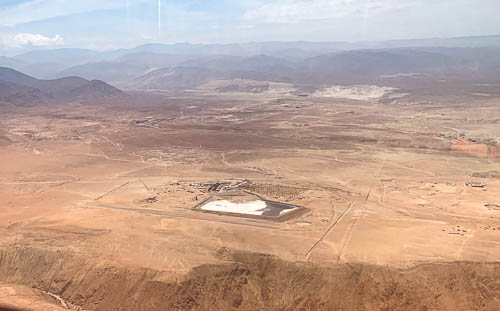
I overfly the paved runway and look for a windsock or any wind indication but couldn’t find any. The runway has a significant slope, so I decide to land uphill – and land with a strong tailwind. A new but unspectacular experience as it is nevertheless a safe landing - the runway is long and smooth. Now, where should I park? There is only the runway, carved out of the bedrock. No taxiway, no apron. I park the Cessna in a little enclave, in an attempt not to block the runway. Everything is quite now.
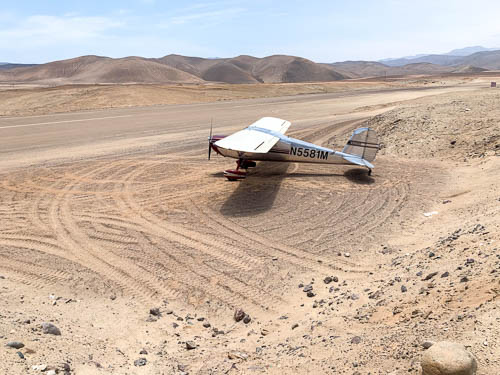
But my arrival is not unnoticed. I see a worker on a little towering structure in the distance, looking at me. But nothing happens. No cell connection. I try my satphone, it workes. The owner of Chala had allowed me to use his airstrip and I am very grateful for this. He did organize fuel for me. I arrived early, so I waited patiently. Exactly at the advised time, a truck loaded with fuel containers arrives. They use a small pump to pump 12 gallons of auto gasoline into my Cessna. We exchange a few nice words. I can’t really tell how happy I am to get this supply here in the desert. Without this, I could not have made it through southern Peru. Do you need anything else?, they ask. I don’t and they leave.
The departure time of my second flight plan said that I would takeoff in 1,5 hours and I had no good means to change this time and didn’t want to get into any trouble, so I waited patiently in the shade under my wing. Happy that I brought a mattress, so I could lie down and stretch a bit. When the time is right, I start the engine. It kicks up so much dust, that I loose complete sight during taxi – another new experience for me. Of course, I take off downhill, with a head wind. Right after takeoff, I have good cell connectivity and hear the chime of incoming WhatsApp messages in my Bluetooth connected Bose headset. Can’t resist and send a picture right away.
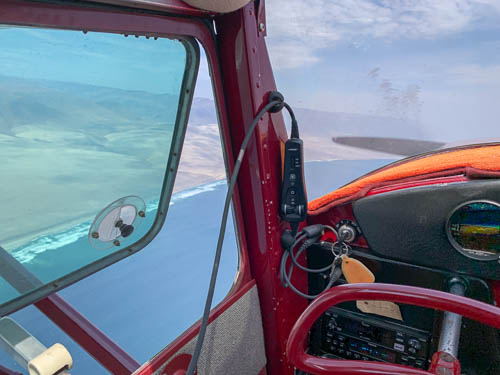
Shouldn’t do this! Listen PPL-students, don't text and fly. Especially when you are flying alone, without auto pilot, close to the ground in an unfamiliar environment. Again, following the coastline, two hours to Mollendo. Tried all the frequencies but heard nobody. I pass a few rivers, flowing into the Pacific. Lush green divides the orange-brown of the desert.
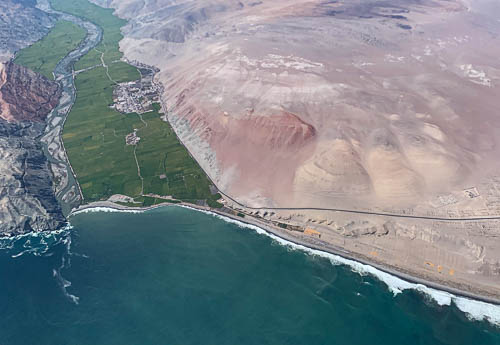
I think Nazca tower asked me, if I want them to open my flight plan for the next leg on time, so I believe my flight plan is open. In field 18, it contains the remark: CANSELA CON ETA, which means ATC will close the flight plan at the expected time of arrival, even if they do not receive any arrival message. It also means, that nobody will look for you, as long as nobody reports your aircraft missing. Sounds scary, but then think that in countries like Germany or the United States, VFR flights without a flight plan are the norm, not the exception. I think, that in countries like Peru, where VFR flights must have a flight plan, CANSELA CON ETA is a valid option, if landing at an uncontrolled field, especially if cell connectivity is not assured.
Mollendo is a public uncontrolled airstrip with an unpaved runway parallel to the beach. In fact, Mollendo’s crowded beaches are so close, that landing aircrafts overfly the partying people in 200 ft. Again, I announce my intentions on the unicom frequency, overfly the strip, look for traffic or a wind indication and see neither. Another dusty landing.
An old man approaches me. Well, he may not be that much older than me, but most people in Peru are young – and this caballero has surely seen a lot of sun. Don’t park there, park closer to the house, he recommends. I taxi over and the Cessna gets even dustier. I think of all the cleaning Alberth and I did and of the air filter, which would need to be changed soon, when operating often in such environments.
Mollendo is not properly fenced and the crowded beaches are too close for me. I am a bit concerned.
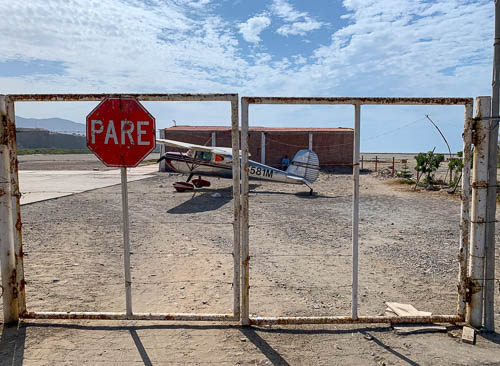
Is it secure here?, I ask myself while I turn the toy key to lock the 1940-area lightweight Cessna quality aluminium lock. You don’t need a screwdriver to rip this aircraft door open. Your fingernail is sufficient. And with a paper clip, you can probably manipulate the lock and open the door without any force at all. Are you guarding this place at night?, I ask the old man. No, I am leaving in an hour, but someone else should come, he replies. He says more, a lot more, but I don’t understand most of it. So I just nod and leave, still concerned.
I walk towards the beach. A powered parachute flies lowly over the crowds, goes full throttle and climbs through the approach path of Mollendo airstrip.
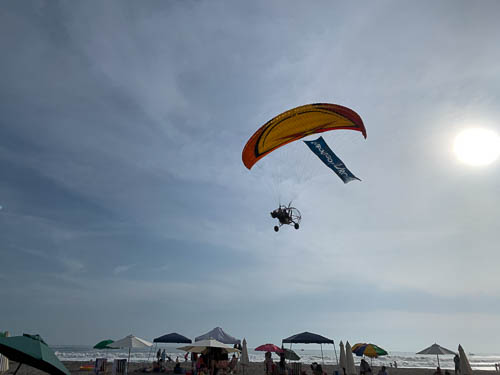
I haven’t seen this guy, while flying in, I think. Hopefully, he saw me. A lot of partying is happening on the beach. It is Saturday afternoon, and the weather is nice. But the sand is grey and the water somehow uninviting. I don’t test it, can’t leave my bag pack unattended. Windy says, the water has only 20 degrees anyhow. Brrrrr, too cold for me. After a mile of walking, I leave the road and take a taxi to my booked family hospedaje. It was wise to book early, because Mollendo city is as crowded as its beaches. It is a high season weekend. Apparently, the family owning this accomodation business is doing everything right. All their neighbors live in shabby huts, but my large third-floor room towers the neighborhood, offering a nice view over the city of Mollendo:

As the last action of the day, I file a flight plan from Mollendo to Tacna for the next day. After two long flights, I sleep well. Always impressing, how exhausting these flights are. Or am I getting old?
I leave my hotel early and walk to the city center, looking for breakfast. What I find is a Senora offering fresh orange juice. She uses a different technique to the one I am used to. We usually cut the oranges in half and put them with their shelf in the press. But she removes the shelves first, before squeezing them. This seems like a lot more work, but probably increases the efficiency of getting the juice out of the orange. Finding a healthy breakfast is impossible. In the end, I buy sandwiches and eat them on my way back to the airstrip.
The old man is already there. He was here all night, he claims. But maybe the truth gets lost in translation. I give him nevertheless some money for guarding my aircraft, relieved that everything is just as I left it. To refuel the bird, I must unload it completely. The fuel containers are below all the other stuff. Carefully I place everything in the dust. I have so much stuff – and it is getting more and more. The ease with which I fueled two years ago is gone. Now I know that I should use a fuel filter, to avoid particles getting into the tank. I wish I had the fuel filter Horacio showed me two weeks ago. More stuff I should carry. Preflight includes cleaning the dusty wind shield. No, there is no water at this airfield. We use drinking water for this, the guard explains. I thank him, start the engine, kicking up dust again. Take-off is easy and the freedom feels absolute. I love small airfields. But I prefer gras runways to dust strips. Actually, dust is pretty awful, if you care for your aircraft.
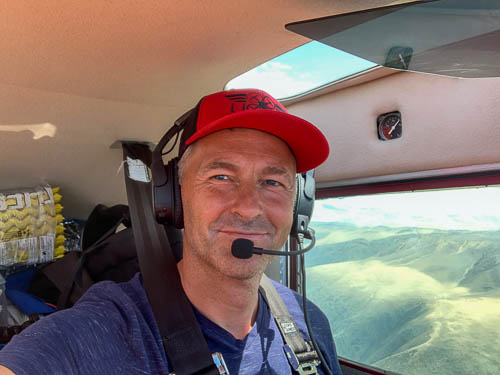
Flight time to Tacna is only 1,5 hours. Along the coastline again. After a while, I hear pilots in contact with Tacna tower. But it takes a long time, until they hear me, Tacna is in a valley, shading radio waves. What are your intentions? asks the English-speaking lady. Doing customs, I answer. Use parking stand 1, she advises after landing. The other stand is used by an A320. Do you really want me to block one of the only two airliner sized parking stands overnight? I ask. She doesn’t mind or cares.
Before taking off in Mollendo, I had changed my clothes. I am now wearing long pants, so I look more civilized. It is hot and I hate wearing them, but you must do concessions to civilization.
An airport official approaches the Cessna, but strangely doesn’t come close. Normally, they all want to take a picture of my oldtimer. Maybe some rule doesn’t allow him to get close to an aircraft. There are so many strange rules at these controlled airports. I put on my yellow vest, arrange my tapa boca and follow him to his office. First and most important, we make a GenDec. Then he asks me to write an email requesting custom services for tomorrow. Strange, I thought customs will be available all the time. So many local procedures stay unclear, when you don’t speak the language properly and especially, when you are doing things for the first time.
I leave the airport and go to the tent for the PCR test. The young lady asks me many questions about apps and QR codes and I again don’t understand what she wants to tell me. Why can’t she just do the test and email me the result? Nariz or boca?, she asks. What a nice question! Normally, they don’t ask. I prefer being tested in the mouth. When being tested through the nose, I always fear that they damage my brain, because some stick it in too far up. Tomorrow morning, you will get the results, I understand. Ok, so I seem to have booked the 20-hour test. Well, this makes tomorrow’s plans interesting. We will see, how this all works out. A taxi drives me to a cheap hotel. Why am I so tired again? After a single short flight? Strange. Good night.